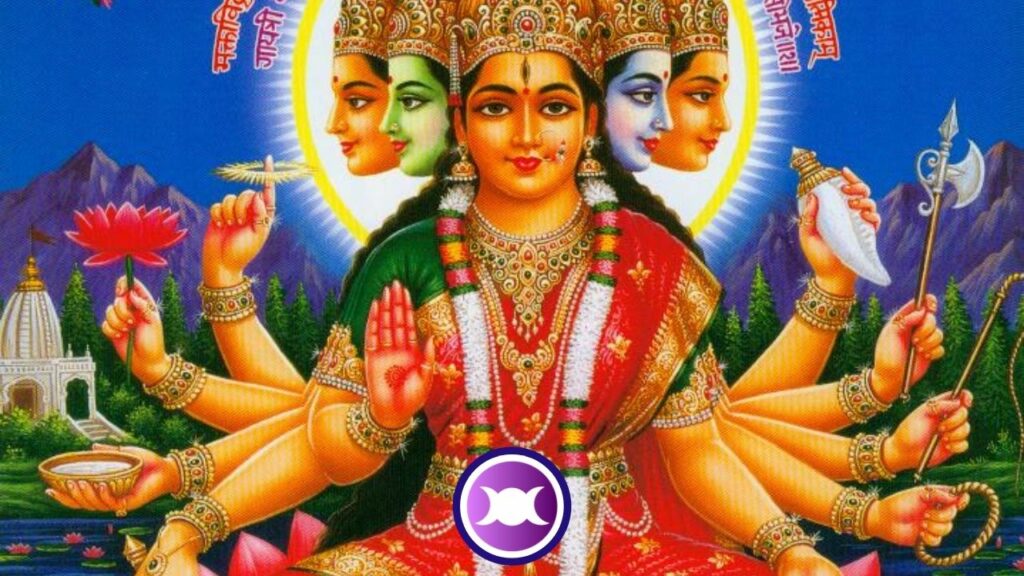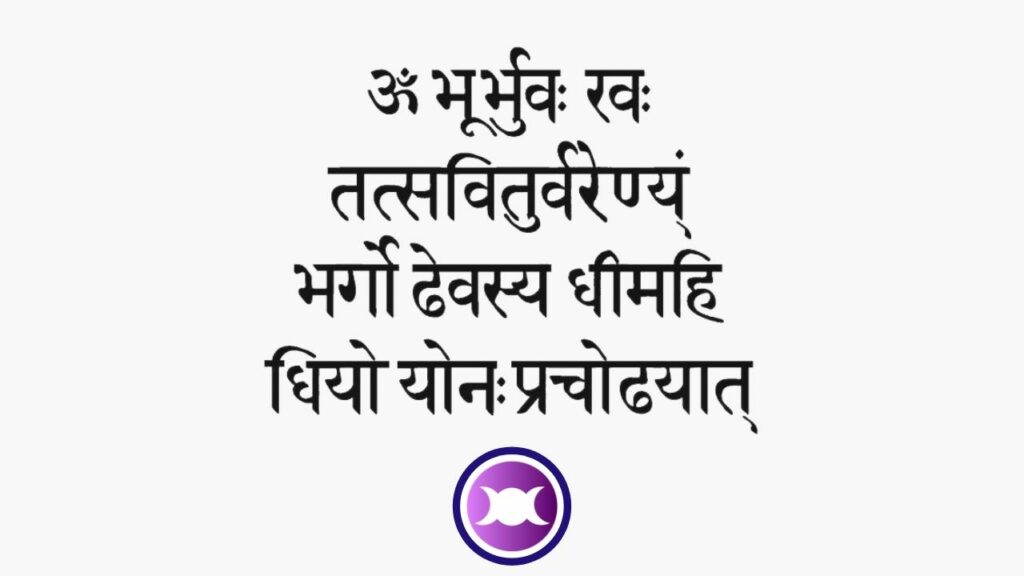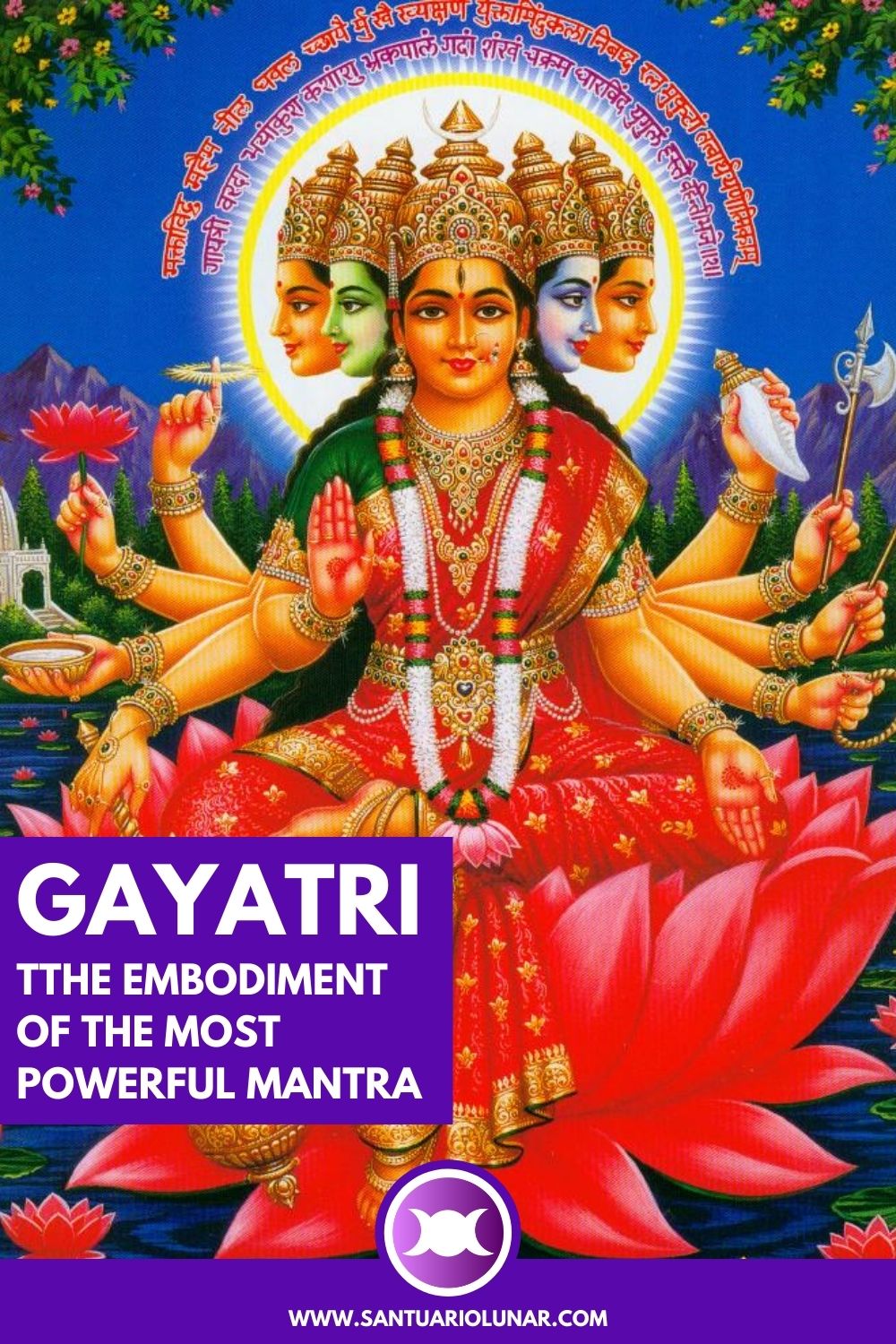Goddess Gayatri is one of the most popular Hindu Goddesses of all. In Hinduism, she is the embodiment of Gayatri Mantra, the most powerful mantra of all.
This mantra is considered the most sacred part of Rigveda. Among the earliest creations of Brahma are Goddess Saraswati and her.
However, it’s common to read that both Goddesses are manifestations of the same being. So you’re probably going to read that Brahma took Saraswati as his wife or her as his wife.
You can watch a video below in which I tell her story and her archetype. Feel free to subscribe to my YouTube Channel too.
In Neo-Paganism, we can consider her as part of the Mother Face of the Triple Goddess.

How is Goddess Gayatri portrayed?
Gayatri is typically portrayed sitting on a red lotus, which means wealth and she can appear in two different forms.
The first one depicts her with five different faces:
- Mukta;
- Vidruma;
- Hema;
- Neela;
- Dhavala.
These faces represent the pancha pranas / pancha vayus (senses/winds).
She also has ten arms and ten eyes. Her eyes face eight different directions beyond heaven and earth and her arms hold all the weapons of the Trimurti: Brahma, Vishnu and Shiva.
The other common depiction shows her beside a white swan, holding scriptures (denoting knowledge) in one hand and a vase in another, symbolizing healing.
In this way, she is the Goddess of education, a similar archetype we find in Goddess Saraswati.
- Attributes: Embodiment of Gāyatrī Mantra, Goddess of wealth, education and Mother of Vedas
- Symbol: Gāyatrī Mantra (ॐभूर्भुवस्व)
- Place: India
Gayatri, as well as other Hindu Goddesses (Devi) are in my free Goddess Oracle! Use the button below to access it, flip a card and receive a message from a Goddess!
Gayatri Mantra meaning
Goddess Gayatri is the personification of the Mantra. Right? But what’s the meaning of Gayatri Mantra? What exactly is this mantra?
Hinduism has got an extensive system of sacred scriptures called Vedas. There are four works written in Vedic Sanskrit (which later gave rise to classical Sanskrit) dating back to a long time.
The most ancient text is Rigveda, written between 2000 BCE and 1500 BCE. And it is precisely here that Gāyatrī Mantra (ॐभूर्भुवस्व) is written for the first time.

Scholars believe that this Mantra was taught orally many years before, though.
Being the second most revered mantra in Hinduism, behind only Om (ॐ), this Mantra also summons Savita, the Solar Indian Diety, and for this reason, it is also called as Sāvitrī.
According to the Hindu beliefs, the knowledge recorded in the Vedas represents all the “truth.”
Being “mother of the Vedas”, we can also interpret her as “mother of truth”.
The lyrics of Gayatri Mantra are the following:
Om bhur bhuvaha svaha
Tat savitur varenyam
Bhargo devasya dhimahi
Dhiyo yonah prachodayat
And the meaning of Gayatri Mantra is something incredible. A user shared with me this wonderful comment on my YouTube channel and here it is:
The Gayatri mantra is like the celestial tree.
A comment from Team Sai Sada on my YouTube channel
The ‘Om’ in that incantation is the trunk that came out of the Earth.
By reciting Om, one can obtain the knowledge about the existence of God and the devotion towards God.
The trunk has developed into three branches as Bhū, Bhuva, and Svaha.
Bhū is capable of imparting the knowledge of self.
Bhuva suggests that the karma yoga is to be followed by the living beings when they hold a body.
Svaha helps in maintaining equipoise amidst all pairs of opposites and attain the state of samādhi.
From the branch Bhū, three sub-branches named Tat, Savitu, and Varenyam came out.
Tat gives the wisdom of life to the individual, Savitu gives strength to the bodily being, and Varenyam helps man to transcend animal instincts and transform into a divine personality.
From the branch Bhuva, three sub-branches namely Bhargo, Devasya, and Dhīmahi originated.
Bhargo enhances purity. Devasya bestows super natural sight possible only for celestials. Dhīmahi improves good qualities.
From the branch Svaha, three sub-branches namely Dhī Yo, Yonah, and Prachodayāt came out.
Dhī Yo develops discrimination, Yonah develops restraint, and Prachodayāt develops spirit of service in all living creatures.
Therefore, know that Gayatri — the celestial tree — has three branches and each branch has three sub-branches. “
You can chant the Gayatri Mantra, 108 times, here:
Gayatri in popular culture
Gayatri and her mantra became extremely popular in our modern society after the American singer Cher listened to Deva Premal’s version of the mantra during a Yoga class.
Cher stated that Premal’s album was her favorite CD to play during the classes.
After that, she presented herself a live version of this Mantra during the Living Proof: Farewell Tour from 2002 to 2005.
This mantra also featured in other productions such as the opening of Battlestar Galactica Season 1 in 2004.
There are numerous versions of the mantra available on Spotify and other streaming platforms. You can find from “classical” Indian versions to modern interpretations chanting these powerful words.

